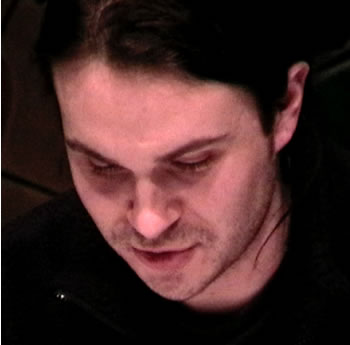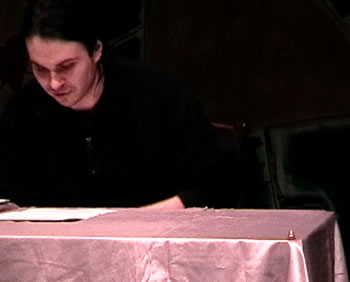It is difficult to
assess the spontaneity of the vocal lines without comparison to other
performances from around the same time, none of which are currently available.
Later versions of 'Approximate' sound increasingly 'fixed' so as to accelerate
performance tempo. It is tempting to assume that the same applies to these
lyrics. This theory is backed up by a copy of the score provided by Barrow,
showing in his own handwriting, the word 'cornhole' written in pencil,
above the music. However, changing the words to songs was extremely common
at live concerts.
But Zappa was not
simply fixing the infinite; he was applying the principal of cryptography,
aiming to disguise a message behind a screen of gibberish. Each line of
lyric acts as a conceptual trigger. Bottles of Heinz Tomato Ketchup conspicuously
made their way onto the front of two albums in 1984, Them or Us
and The Perfect Stranger by way of Donald Roller Wilson’s artwork.
The word 'Ketchup' can be traced to 'San Ber’dino' and 'When The Lie’s
So Big'. The theme of making/preparing food is common in Zappa, but unusual
in popular music, some examples occur in 200 Motels (1971) 'Sealed
Tuna Sandwich' ('This town is just a sealed tuna sandwich with the wrapper
loose'), Joe’s Garage (1979) 'Crew Slut' ('add water, makes its
own sauce'), Broadway the Hardway (1988) 'Why don’t you like me'('Make
me a sandwich!'). 'Dagmar' appears for the first time on Sheik Yerbouti
as the drag queen at The Grape nightclub in 'Broken Hearts Are For Assholes'.
By 1982, 'Stayin’ Alive' by the Bee Gees was assimilated into 'Approximate';
the inclusion of a line from such a rhythmically simple song, in such
a rhythmically complicated one, emanates Zappa humour. The final line
is most likely inspired by an uncharacteristically, banal moment during
a Mothers of Invention concert in 1969, when Zappa announced to the audience
that a Chevrolet, parked outside, needing moving. It is also the most
obscure line.
Then, suddenly…
Today, with new pop
acts under pressure to enter the charts or be dropped, performances are
carefully worked out in advance, effectively ruling out the possibility
of unplanned events. But apart from computerised dance music, it is difficult to remove them
all, since musicians are never 100% accurate. Wrong notes notwithstanding,
musicians always make subtle tempo and dynamic variations. Since Zappa’s
death, other methods of randomising music have evolved in the form of
sound manipulation software packages and plug-ins with randomisation facilities
[19]. But these are rarely used in ways that might challenge listeners,
especially in chart-orientated pop [20]. This is not surprising since
popular music is designed to be instantly catchy, a quality depending
on repetition and structural conformity. A pop song, which changes each
time it is performed, would soon be under pressure from the powers that
be, the record executives and other dip-shits, to become fixed in the
form of a definitive version. But somehow Frank Zappa managed to do things
his way, and for that we should all eat our greens and things that look
like meat.
But apart from computerised dance music, it is difficult to remove them
all, since musicians are never 100% accurate. Wrong notes notwithstanding,
musicians always make subtle tempo and dynamic variations. Since Zappa’s
death, other methods of randomising music have evolved in the form of
sound manipulation software packages and plug-ins with randomisation facilities
[19]. But these are rarely used in ways that might challenge listeners,
especially in chart-orientated pop [20]. This is not surprising since
popular music is designed to be instantly catchy, a quality depending
on repetition and structural conformity. A pop song, which changes each
time it is performed, would soon be under pressure from the powers that
be, the record executives and other dip-shits, to become fixed in the
form of a definitive version. But somehow Frank Zappa managed to do things
his way, and for that we should all eat our greens and things that look
like meat.
References
[1] Los Angeles
Times, 1 October 1992. Interview with Frank Zappa, http://www.science.uva.nl/~robbert/zappa/interviews/LA_Times.html
[2] Courrier, Kevin,
Dangerous Kitchen: The Subversive World of Zappa, EWC Press, Toronto,
2002, p. 131. This piece was eventually released on Lumpy Gravy
(1968).
[3] Frank Zappa,
'Louie Louie', Uncle Meat, 1969.
[4] Frank Zappa,
'Cocaine Decisions', You Can’t Do That On Stage Anymore, Vol. 3.,
1988.
[5] '[…] (The musicians)
are given different rows of notes to use against each chord but they choose
their own notes and play them in their own style […]', Diane Dorr-Dorynek
citing Mingus in the liner notes to Charles Mingus, Mingus Ah Um,
1959.
[6] Richter, Hans,
Dada: Art and Anti-art, Thames and Hudson, London, 1997, p. 51.
[7] Ibid., p. 57.
[8] Landy, Leigh,
'Duchamp Dada Composer and his Vast Influence on Post-World War II Avant-garde
Music'.
[9] Review from Oor
magazine, 27 September 1972, translated from Dutch by Jillis
Stada (edited by Charles Ulrich).
[10] This comes from
a bootleg recording of Zappa at the Hollywood Bowl, 10th September,
1972.
[11] Frank Zappa,
Dub Room Special, Honker Home Video, 1982.
[12] As opposed to
'heart -turning', Out To Lunch’s description of Evil Dick and the Banned
Members.
[13] Arthur Barrow
on 'Approximate' in correspondence with the author, 6 December 2002. Arthur
kindly answered my questions and provided me with a scan of Approximate
(for study purposes only!) upon which many of these new revelations are
founded. Cheers Arty!
[14] Chevalier, Dominique,
Viva Zappa, Omnibus Press, London, 1986, p. 113. Citing The Grand
Wazoo’s tour programme, 1972.
[15] The experiments
of Lantz and Cuddy conclude that the duration, rather than the rate of
recurrence of a pitch, plays a more crucial role in establishing the tonal
centre. Lantz, M.E. and Cuddy, L.L., 'The Effects of Surface Cues in the
Perception of Pitch Structure; Frequency of Occurrence and Duration',
ICMPC proceedings (1996), pp. 281-286.
[16] Occurring from
18 sec. to 21 sec. in the Stage 2 version and from 33 sec. to 37
sec. in the Stage 4 version (times measured from first notes of
each piece).
[17] Chevalier, Dominique,
Viva Zappa, Omnibus Press, London, 1986, p. 113.
[18] Watson, Ben,
Frank Zappa: The Negative Dialectics of Poodle Play, Quartet Books,
London, 1993, p. 229.
[19] Typical exponents
of such technologies are the group Mouse on Mars.
[20] Unless, of course,
you are listening to Rock ‘n’ Random (2002) by Evil Dick and the
Banned Members.
Back
to ICE-Z
Get You Back Home

 But apart from computerised dance music, it is difficult to remove them
all, since musicians are never 100% accurate. Wrong notes notwithstanding,
musicians always make subtle tempo and dynamic variations. Since Zappa’s
death, other methods of randomising music have evolved in the form of
sound manipulation software packages and plug-ins with randomisation facilities
[19]. But these are rarely used in ways that might challenge listeners,
especially in chart-orientated pop [20]. This is not surprising since
popular music is designed to be instantly catchy, a quality depending
on repetition and structural conformity. A pop song, which changes each
time it is performed, would soon be under pressure from the powers that
be, the record executives and other dip-shits, to become fixed in the
form of a definitive version. But somehow Frank Zappa managed to do things
his way, and for that we should all eat our greens and things that look
like meat.
But apart from computerised dance music, it is difficult to remove them
all, since musicians are never 100% accurate. Wrong notes notwithstanding,
musicians always make subtle tempo and dynamic variations. Since Zappa’s
death, other methods of randomising music have evolved in the form of
sound manipulation software packages and plug-ins with randomisation facilities
[19]. But these are rarely used in ways that might challenge listeners,
especially in chart-orientated pop [20]. This is not surprising since
popular music is designed to be instantly catchy, a quality depending
on repetition and structural conformity. A pop song, which changes each
time it is performed, would soon be under pressure from the powers that
be, the record executives and other dip-shits, to become fixed in the
form of a definitive version. But somehow Frank Zappa managed to do things
his way, and for that we should all eat our greens and things that look
like meat.